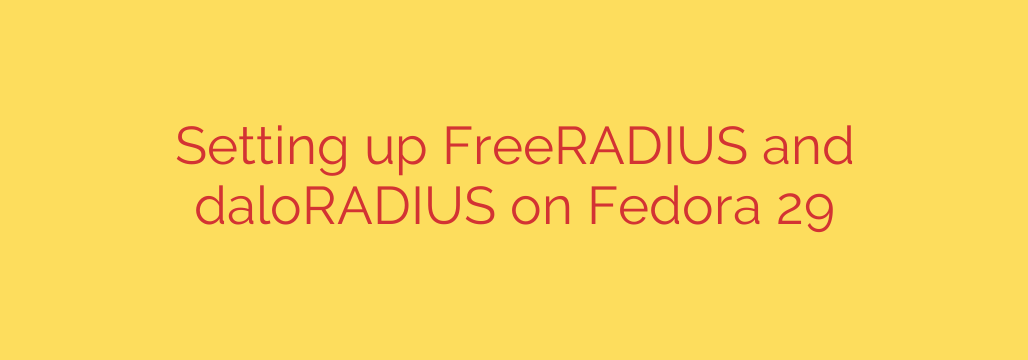
How to Install and Configure FreeRADIUS with a daloRADIUS Web Interface
Managing network access and user authentication can be a complex task, especially as your network grows. A centralized authentication system is the gold standard for security and efficiency. This is where a RADIUS (Remote Authentication Dial-In User Service) server becomes invaluable.
FreeRADIUS is the most popular open-source RADIUS server in the world, providing robust and flexible Authentication, Authorization, and Accounting (AAA) services. However, managing it through the command line can be cumbersome. That’s where daloRADIUS comes in—a powerful web-based application designed to manage FreeRADIUS servers with ease.
This guide will walk you through the complete process of setting up a powerful FreeRADIUS server on a modern Linux system (like Fedora, CentOS, or RHEL) and managing it with the user-friendly daloRADIUS web interface.
Prerequisites: What You’ll Need
Before we begin, ensure you have the following ready:
- A running Linux server (this guide uses commands for Fedora/RHEL-based systems).
- Root or
sudoprivileges. - A functional LAMP or LEMP stack (Linux, Apache/Nginx, MariaDB/MySQL, and PHP).
- Basic knowledge of the Linux command line.
Step 1: Install the Core Server Components
First, we need to install the necessary software packages from the official repositories. This includes the FreeRADIUS server itself, a database server (we’ll use MariaDB), the Apache web server, and PHP.
Install FreeRADIUS and MariaDB
Open your terminal and run the following command to install FreeRADIUS, its MySQL compatibility module, and the MariaDB database server.
sudo dnf install freeradius freeradius-mysql mariadb-server -yStart and Secure MariaDB
Once installed, you need to start the database service and enable it to launch on boot.
sudo systemctl start mariadb sudo systemctl enable mariadbNext, run the secure installation script. This is a critical security step that removes insecure default settings, sets a root password, and locks down your database.
sudo mysql_secure_installationFollow the on-screen prompts, making sure to set a strong root password.
Install Apache and PHP
Now, install the Apache web server and the required PHP modules for daloRADIUS to function correctly.
sudo dnf install httpd php php-mysqlnd php-gd php-pear -yAfter the installation, start and enable the Apache service.
sudo systemctl start httpd sudo systemctl enable httpd
Step 2: Configure FreeRADIUS with a MySQL Backend
By default, FreeRADIUS uses flat files for configuration. For a scalable and manageable setup, we’ll configure it to use our MariaDB database instead.
Create the RADIUS Database
Log into your MariaDB server using the root password you set earlier.
sudo mysql -u root -pNow, create a dedicated database and a user for FreeRADIUS. Replace
'your_strong_password'with a secure password of your own.CREATE DATABASE radius; GRANT ALL PRIVILEGES ON radius.* TO 'radius'@'localhost' IDENTIFIED BY 'your_strong_password'; FLUSH PRIVILEGES; EXIT;Import the FreeRADIUS Schema
FreeRADIUS comes with a predefined database schema. We need to import it into the
radiusdatabase we just created.sudo mysql -u radius -p radius < /etc/raddb/mods-config/sql/main/mysql/schema.sqlYou will be prompted for the
radiususer’s password.Link FreeRADIUS to the Database
Next, we need to tell FreeRADIUS how to connect to our database. Edit the SQL module configuration file:
sudo nano /etc/raddb/mods-available/sqlInside this file, locate the
sqlsection and make the following changes:- Set the
driverto"rlm_sql_mysql". - Set the
dialectto"mysql". - In the
connection_infosection, update the following:server="localhost"login="radius"password="your_strong_password"radius_db="radius"
Save and close the file. Now, enable the SQL module by creating a symbolic link from the
mods-availabledirectory to themods-enableddirectory.sudo ln -s /etc/raddb/mods-available/sql /etc/raddb/mods-enabled/- Set the
Test Your FreeRADIUS Configuration
Before proceeding, it’s wise to test the setup. Run FreeRADIUS in debug mode to see its output.
sudo freeradius -XLook for the line
Ready to process requests. If you see this without any major errors, your connection to the database is successful. You can stop the process withCtrl + C.
Step 3: Install and Set Up daloRADIUS
With the backend configured, it’s time to install the web interface.
Download and Place daloRADIUS
Download the latest version of daloRADIUS from its official repository (usually GitHub) and place it in your web server’s root directory.
cd /tmp wget https://github.com/lirantal/daloradius/archive/master.zip unzip master.zip sudo mv daloradius-master /var/www/html/daloradiusImport the daloRADIUS Database Tables
daloRADIUS requires additional tables in your
radiusdatabase. Import them from the provided SQL file.sudo mysql -u radius -p radius < /var/www/html/daloradius/contrib/db/fr2-mysql-daloradius-and-freeradius.sqlConfigure daloRADIUS Connection
Copy the sample configuration file and edit it to match your database settings.
sudo cp /var/www/html/daloradius/library/daloradius.conf.php.sample /var/www/html/daloradius/library/daloradius.conf.php sudo nano /var/www/html/daloradius/library/daloradius.conf.phpUpdate the following database variables:
$configValues['CONFIG_DB_HOST']='localhost';$configValues['CONFIG_DB_USER']='radius';$configValues['CONFIG_DB_PASS']='your_strong_password';$configValues['CONFIG_DB_NAME']='radius';
Save and close the file.
Set File Permissions
The web server needs permission to write to the daloRADIUS directory. Set the correct ownership.
sudo chown -R apache:apache /var/www/html/daloradius
Step 4: Final Security and Configuration
Your setup is almost complete. These final steps are crucial for security and proper operation.
Configure Firewall Rules: Your server’s firewall must allow traffic for RADIUS and the web interface.
sudo firewall-cmd --permanent --add-port=1812/udp --add-port=1813/udp sudo firewall-cmd --permanent --add-service=http --add-service=https sudo firewall-cmd --reloadAdjust SELinux Policies (If Applicable): On systems like Fedora or CentOS, SELinux may block Apache from making network connections to the database. Run the following command to allow it:
sudo setsebool -P httpd_can_network_connect_db 1Update RADIUS Clients: Edit the
/etc/raddb/clients.conffile to define the network devices (like routers or wireless access points) that will be using this RADIUS server. Crucially, change the defaultsecretto a long, complex, and unique value for each client.Access daloRADIUS: You can now access the web interface by navigating to
http://your_server_ip/daloradius. The default login credentials are:- Username:
administrator - Password:
radius - It is essential that you change this default password immediately after logging in.
- Username:
Conclusion: A Centralized Authentication Hub
You have successfully deployed a powerful and flexible AAA server with FreeRADIUS, backed by a robust MySQL database and managed by the intuitive daloRADIUS web interface. This centralized system not only enhances your network security but also simplifies user management, provides detailed accounting logs, and scales with your organization’s needs. From here, you can start adding users, managing network devices, and creating specific access policies, all from a single, convenient dashboard.
Source: https://kifarunix.com/install-and-configure-freeradius-with-daloradius-on-fedora-29-2/








